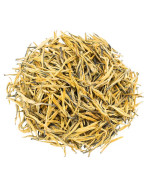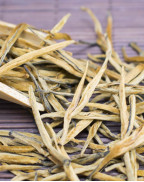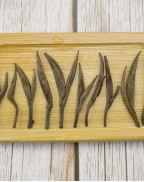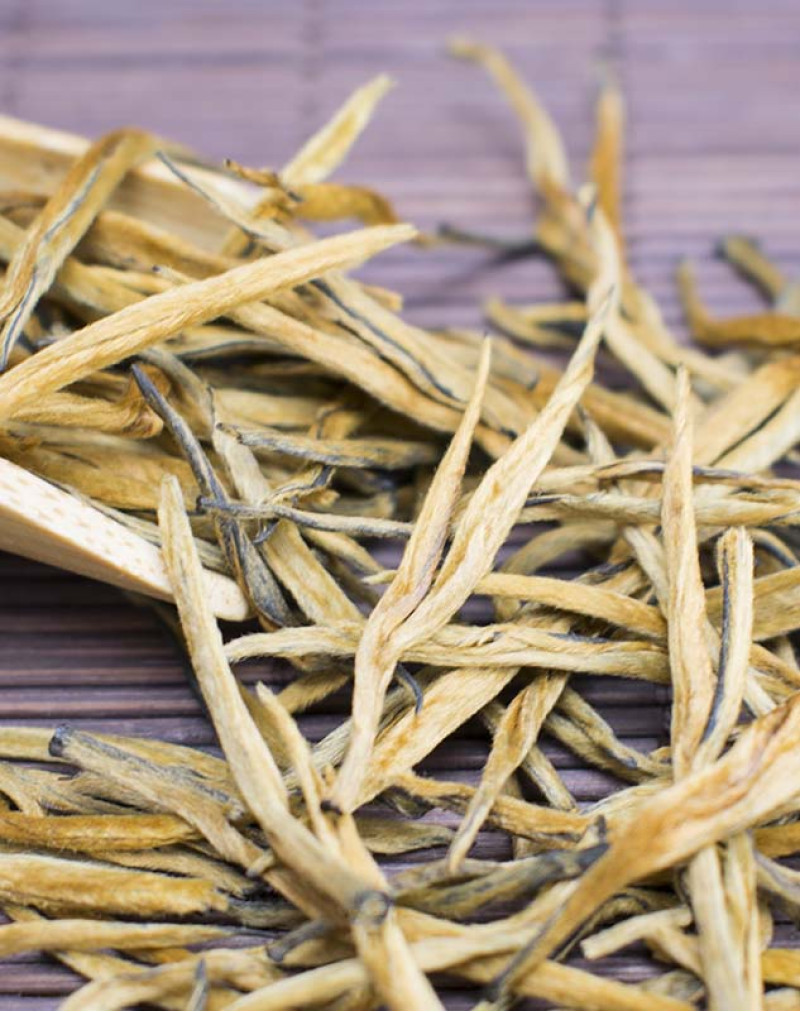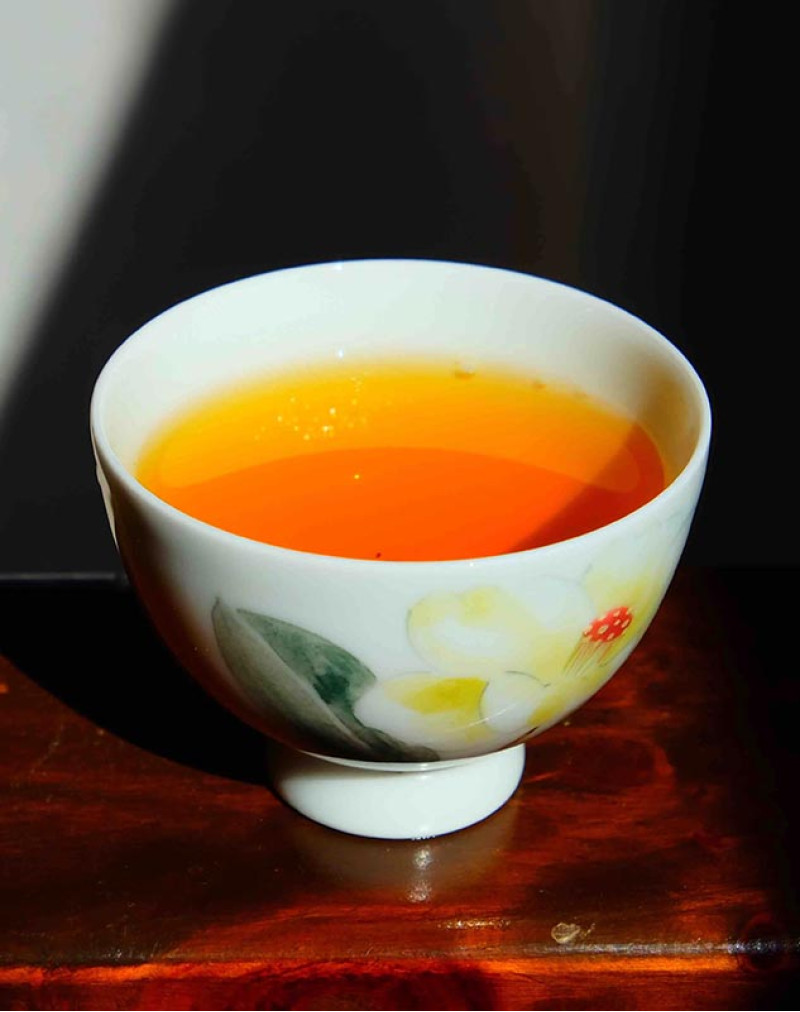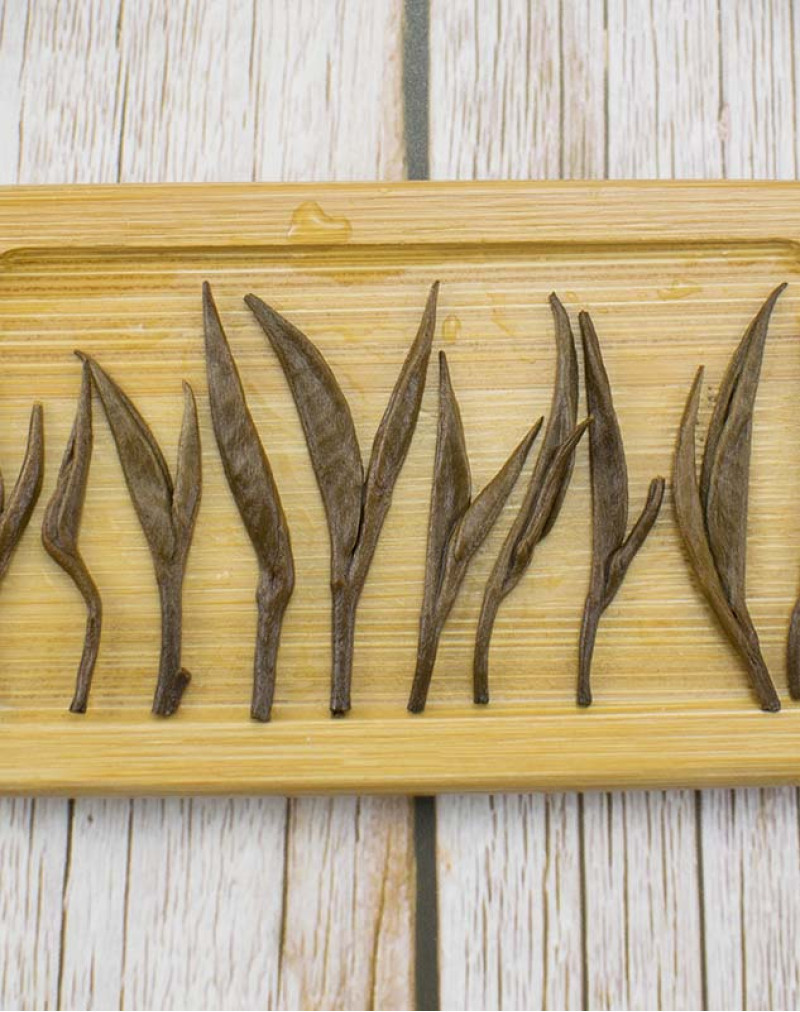Yun Nan Dian Hong Jin Zhen Golden Needle Black Tea
- Product Code: Simple
- Availability: In Stock
Basic Info
Name: Yun Nan Dian Hong Jin Zhen Golden Needle Black Tea
Other name: Yunnan Golden Needles Black Tea/ Dian Hong Jin Zhen Black Tea
Origin: Feng Qing , Lincang , Yunnan
Taste & Aroma: Smooth, sweet, chocolaty,no astringency or bitterness,drinkable
Item Form: Loose leaves
Ingredients: Buds only
Caffeine: Low
Liquor: Bright reddish brown color with luster
Dry Leaf: Evenly rolled up, straight, slender in black and gold with sharp points
Harvest: Spring, 2024
Season: Spring tea
Item Form: Loose Leaves
Altitude: 1300 m
Ingredients: Hand-picked natural tea buds and leaves
Storage: Stored in cool, airtight, opaque containers - refrigeration is recommended
Shelf Life: 18months at room temperature / 24 months with low temperature storage
Flavor: Unflavored
Yun Nan Dian Hong Jin Zhen Golden Needle Black Tea
Yun Nan Dian Hong Jin Zhen Golden Needle Black Tea
Harvested in the middle of April processed with traditional methods, Our Yun Nan Dian Hong Jin Zhen Golden Needle Black Tea is a new variety of yunnan black tea. It is a famous black tea made by introducing new processing technology on the basis of traditional Yunnan congfu tea.It is very sweet and has a slight baking background, mild aroma with no astringency.
This Black tea comes from Yunan Province, where famous Pu-erh tea is grown. It is a modern type black tea created by Yunnan tea makers on the basis of the traditional Dianhong tea technology by introducing the new manufacturing process called "Li Tiao 理条" ,right after fermentation.
Dian Hong Golden Needle Tea comes from an old tea garden in southern Yunnan at an altitude of about 1300 meters. This tea garden is far from the city, with fresh air and clean water sources, which is very conducive to the growth of good tea. With the guidance from the senior tea technical staff, this product is a kind of tea by manual work with no pollution, no poison on it.

Show Full Description
The history of black tea in Yunnan Black Tea
Yunnan black tea is called Dianhong (Diān hóng 滇红) for short, which belongs to black tea category. It was first produced by tea farmers in the 1930s.
In September 1938, commissioner Zheng Hechun and technician Feng Shaoqiu were sent by the China Tea Company to Yunnan Province to investigate tea production and marketing in Yunnan.
They arrived in Fengqing in November and found that Fengshan in Fengqing County has good natural conditions for the growth of tea trees, so they began trial - producing black tea in Fengqing.
Through continuous efforts, in 1939, the first batch of 500 tons (China weight unit, one load is equal to 50 kilograms) of Yunnan Black tea was successfully trial-produced.
Then the new batch of black tea was transported to Hong Kong within bamboo tea cages, and then put on the market in wooden cases and aluminum cans. Surprisingly, it was warmly welcomed by customers in Hong Kong. It has proved to be a successful tea and eventually named with its place of origin (Dian Hong) by Mr. Feng.
In order to further expand the production of Yunnan black tea.In early 1939, Feng Shaoqiu was ordered to build Fengqing Tea Factory (then called Shunning Experimental Tea Factory). At the same time, a large number of technical personnel from Zhejiang, Anhui, Hunan, Jiangxi and other provinces were called to Yunnan to engage in tea production in Yunnan.
Some local tea farmers often take part in the company's tea training courses, which indirectly provides human resources for yunnan black tea to expand reproduction.
In 1940, yunnan black tea changed its name to "Dianhong", and the name "Dianhong" has been used ever since.At present, yunnan black tea production areas are mainly concentrated in more than 20 counties in six prefectures along the Lancang River in Yunnan, namely Lincang, Baoshan, Simao, Xishuangbanna, Dehong and Honghe.
How many kinds of black tea are there?
Since Yunnan black tea was born on that day, its variety has been increasing continuously. With the continuous improvement of processing technology and the increase of newly cultivated varieties of tea trees, new types of Dian Hong are emerging.It is not easy to figure out how many types of Yunnan black tea are available in the market. Some Yunnan black teas are named after the tree species, some after the origin, some after the raw material, such as bud black teas, some after the shapes such as some Yunnan black teas on our website are needle shaped, silk shaped, spiral shaped. It is difficult to directly distinguish the quality of tea from its name, because each kind of tea has its fans. We can try several kinds slowly to find the one we like.
Yunnan Province
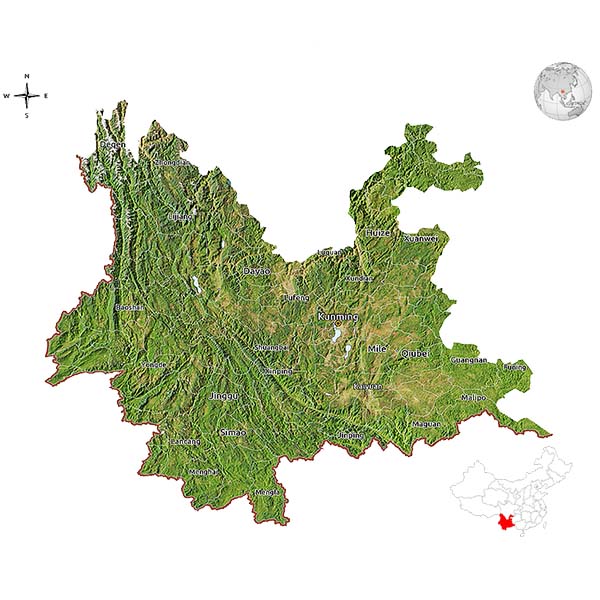
Yunnan is one of the oldest tea-cultivating regions in the world and produces some of the best known teas in the world. Especially yunnan black tea (also called Dianhong) and Pu 'erh tea. According to textual research, Yunnan has been growing tea for more than 2000 years.
Yunnan borders China's Guizhou, Guangxi, Sichuan and Tibet autonomous regions, as well as Viet Nam, Laos and Myanmar. Yunnan is a mountainous plateau, with an altitude of 1,000-3,500 meters accounting for 87.21% of the total land area of the province, and most of the area of Yunnan Province is located in the middle altitude area. The area with a gradient of less than 25 accounts for 56.46% of the total land area. In terms of landform types, plain, terraces, hill and mountain account for 4.85%, 1.55%, 4.96% and 88.64% of the total land area respectively.Geographical location of Yunnan
Geographical location of Yunnan
Yunnan is influenced by the monsoon climate of subtropical plateau, and has three climatic zones: cold, warm and hot (including subtropical zone). Yunnan has a diverse climate, complex terrain and mountains, but it has a mild climate and strong seasonal rainfall, which is consistent with Asian monsoon model. It is very humid in summers and dry in winters. In the warmest place in the province, the climate is more like the dry and humid tropical climate, only slightly colder in winters. The colder areas are subtropical areas, and the winters are cool and dry. Generally speaking, the average temperature will drop by 0.6 ~ 0.7℃ for every 100 meters above sea level. There is a saying that "a mountain has four seasons, and the climate is different within ten miles".
The climate in Yunnan is very conducive to the growth of tea trees.
The key factor of producing good teas in Yunnan is the combination of suitable altitude and low latitude. Specifically, it refers to the conditions of high altitude (between 1200 meters and 1800 meters) and low latitude (about 22 degrees). The areas that meet these two conditions have the following characteristics: the daily temperature difference is very large, the higher the altitude, the colder the night, the hotter the day, and the better the tea quality. Large daily temperature difference is very good for tea quality!
Judging by this condition, we will find that mountainous areas in the middle and lower reaches of Lancang River in Yunnan, especially Xishuangbanna, Pu 'er City, lincang and other areas near the Tropic of Cancer, have reached the best combination of high altitude and low latitude conditions, and is the most suitable area for tea tree growth. The best tea producing areas are Pu 'er City, followed by Baoshan, Dali and Dehong in Dali.
Tea growing in other tea areas (except Laos, Myanmar and Vietnam) outside Yunnan does not meet the first requirement of "the strongest taste" for Pu-erh tea. Teas grown outside those regions in Yunnan may share characteristics with Yunnan but cannot be named.
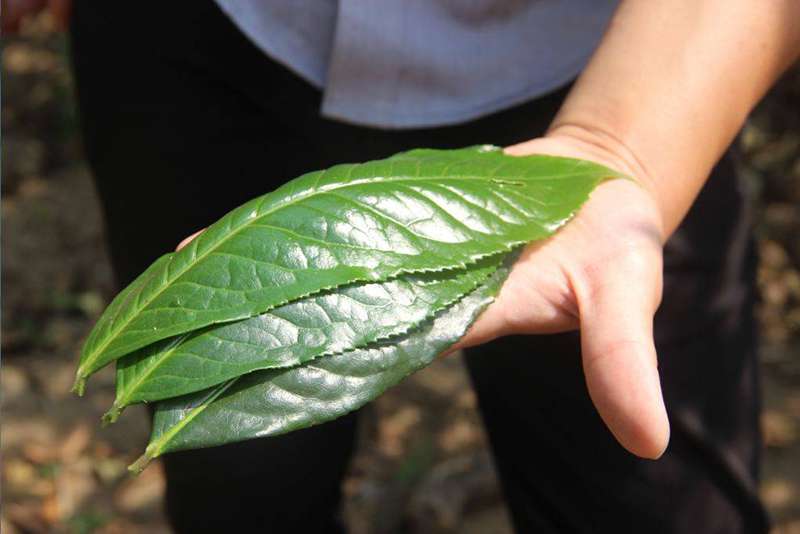
About large-leaf variety
The large-leaf tea tree is a cultivated variety with its own unique characteristics that grows and propagates under the special ecological environment conditions in Yunnan.
It originated in the Lancang River valley in southwest and south of Yunnan Province, and it is one of 30 national tea varieties in China. Yunnan large-leaf tea plants are mostly arbor type, with tall crown, which can grow naturally to 5 ~ 6 m high, up to more than 20 m. The excellent varieties of Yunnan large-leaf species mainly include: Mengku large-leaf species, Fengqing large-leaf species, Menghai large-leaf species, Jingdong large-leaf tea, Jinggu large white tea and Yunnan large leaf species tea, which contains rich substances. The famous Pu-erh tea only uses the leaves of Yunnan large-leaf species as raw materials.
Large-leaf variety contains more effective substances such as tea polyphenols and caffeine, which makes the tea taste rich. Therefore, big leaf species are suitable for Pu-erh tea and black tea, while green tea and oolong tea are mainly made with middle-leaf variety.

How to make?
Black tea is divided into Gongfu black tea, souchong (xiaozhong) black tea and broken black tea (CTC). The processing steps of each tea are slightly different.Their basic production process is: picking/Plucking - withering - kneading/rolling - fermentation - drying - screening - packaging.
1.Plucking
The harvesting of Yunnan black tea usually starts from mid-March to mid-November and lasts about 8 months. Spring tea picked from mid-March to mid-May accounts for 55% of the total annual output, summer tea from mid-May to mid-August accounts for about 30% of the whole year and the production of autumn tea from late August to mid-November accounts for about 15% of the annual production. The standards for picking varies according to the different tea grades. Considering the quality and output, one bud and two or three leaves are picked, except that one bud and one leaf are required for super grade Yunnan black tea.
2.Withering / wiltinger
Withering is the first working procedure of black tea production and the basic process of forming the quality of black tea. Withering has two purposes: first, its purpose is to evaporate some water so as to be rolled into strips and allows a very small amount of oxidation; Second, it is beneficial to the change of internal chemical. It plays an important role in promoting the decomposition of leaf proteins into free amino acids and increases the availability of free caffeine, both of which will change the taste of the tea.
3.Rolling (Chinese: 揉捻; pinyin: róu niǎn)
There are three purposes of kneading: first, the green cell tissue of tea is destroyed by kneading, so that the tea juice flows out; Second, the loose leaves are kneaded into a tight straight rope to reduce the size; Thirdly, make the tea juice overflow and gather on the surface of the leaves, which can form a glossy and oily appearance, which is helpful to bring out the tea flavor when brewing.

3.Fermentation
This is the key step to forming the unique quality of black tea. The fermentation of black tea is generally to put the twisted tea into a fermentation basket or fermentation workshop for fermentation. The suitable temperature, humidity and oxygen content for the oxidative polymerization of tea polyphenols should be controlled well in the fermentation process. Generally, the room temperature is 22 ~ 30℃, and the relative humidity is above 90%. Fermentation is the most crucial step in the process of making black tea. In this step, polyphenolic compounds undergo profound changes to form theaflavins, thearubigins, and theafuscin, which make black tea have the characteristics of red soup, red leaves, and sweet taste.
4.Shaping
This technology is not the standard technology for making black tea. If we want black tea to have some unique shapes, such as our spiral tea, we need to use machines or hand to shape fermented tea into various shapes we need.
5.Drying
Drying is the last working procedure of making black tea. Generally, it has to be done twice. The first drying is called 毛火 (rough fire), and the second drying is called 足火 (full fire). There should be a gap between the rough fire and the full fire. It has three purposes: First, quickly inactivate the activity of enzyme with high temperature, prevent enzymatic oxidation, and fix the fermentation quality. The second is to further evaporate water,fix shape,maintain quality. Third, remove the smell of grass and retain the unique sweet smell of black tea.
| Chinese Gongfu Method | |
| Tea | 5g |
| Water | Gaiwan (3oz) |
| Time | 5 steeps: rinse,10s,20s,35s,50s,1m10s |
| Temperature | 85ºC/185ºF |
| Teapot Method | |
| Tea | 7g |
| Water | Teapot (8oz) |
| Time | 3 steeps:1m,2m,3m |
| Temperature | 85ºC/185ºF |



